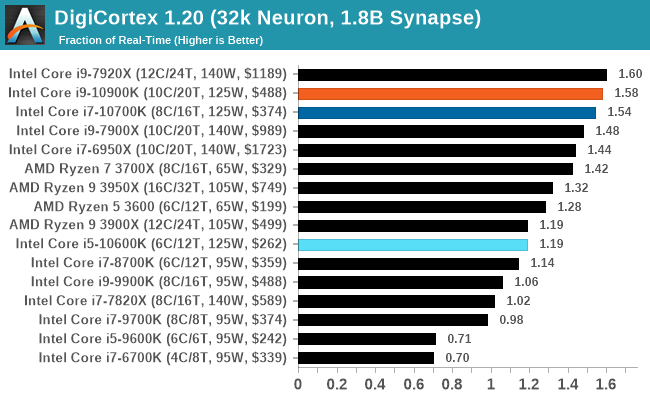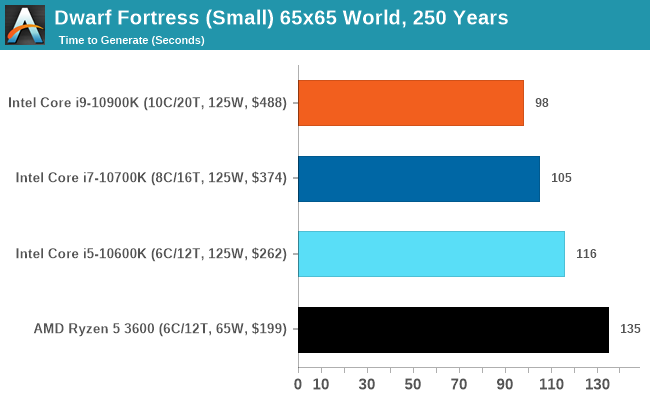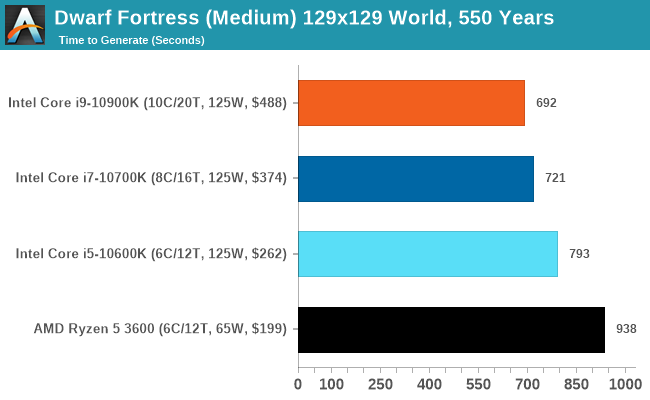The Intel Comet Lake Core i9-10900K, i7-10700K, i5-10600K CPU Review: Skylake We Go Again
by Dr. Ian Cutress on May 20, 2020 9:00 AM EST- Posted in
- CPUs
- Intel
- Skylake
- 14nm
- Z490
- 10th Gen Core
- Comet Lake
CPU Performance: Simulation Tests
A number of our benchmarks fall into the category of simulations, whereby we are either trying to emulate the real world or re-create systems with systems. In this set of tests, we have a variety including molecular modelling, non-x86 video game console emulation, a simulation of the equivalent of a slug brain with neurons and synapses firing, and finally a popular video game that simulates the growth of a fictional land including historical events and important characters within that world.
NAMD ApoA1
One frequent request over the years has been for some form of molecular dynamics simulation. Molecular dynamics forms the basis of a lot of computational biology and chemistry when modeling specific molecules, enabling researchers to find low energy configurations or potential active binding sites, especially when looking at larger proteins. We’re using the NAMD software here, or Nanoscale Molecular Dynamics, often cited for its parallel efficiency. Unfortunately the version we’re using is limited to 64 threads on Windows, but we can still use it to analyze our processors. We’re simulating the ApoA1 protein for 10 minutes, and reporting back the ‘nanoseconds per day’ that our processor can simulate. Molecular dynamics is so complex that yes, you can spend a day simply calculating a nanosecond of molecular movement.
This is one of our new tests, so we will be filling in more data as we start regression testing for older CPUs.

Dolphin 5.0: Console Emulation
One of the popular requested tests in our suite is to do with console emulation. Being able to pick up a game from an older system and run it as expected depends on the overhead of the emulator: it takes a significantly more powerful x86 system to be able to accurately emulate an older non-x86 console, especially if code for that console was made to abuse certain physical bugs in the hardware.
For our test, we use the popular Dolphin emulation software, and run a compute project through it to determine how close to a standard console system our processors can emulate. In this test, a Nintendo Wii would take around 1050 seconds.
The latest version of Dolphin can be downloaded from https://dolphin-emu.org/

DigiCortex 1.20: Sea Slug Brain Simulation
This benchmark was originally designed for simulation and visualization of neuron and synapse activity, as is commonly found in the brain. The software comes with a variety of benchmark modes, and we take the small benchmark which runs a 32k neuron / 1.8B synapse simulation, equivalent to a Sea Slug.
Example of a 2.1B neuron simulation
We report the results as the ability to simulate the data as a fraction of real-time, so anything above a ‘one’ is suitable for real-time work. Out of the two modes, a ‘non-firing’ mode which is DRAM heavy and a ‘firing’ mode which has CPU work, we choose the latter. Despite this, the benchmark is still affected by DRAM speed a fair amount.
DigiCortex can be downloaded from http://www.digicortex.net/

The additional bandwidth of the HEDT platforms put them higher up the chart here - Digicortex always ends up as an odd mix of bottlenecks mostly around memory, but it can be localized internal bandwidth limited as well.
Dwarf Fortress
Another long standing request for our benchmark suite has been Dwarf Fortress, a popular management/roguelike indie video game, first launched in 2006. Emulating the ASCII interfaces of old, this title is a rather complex beast, which can generate environments subject to millennia of rule, famous faces, peasants, and key historical figures and events. The further you get into the game, depending on the size of the world, the slower it becomes.
DFMark is a benchmark built by vorsgren on the Bay12Forums that gives two different modes built on DFHack: world generation and embark. These tests can be configured, but range anywhere from 3 minutes to several hours. I’ve barely scratched the surface here, but after analyzing the test, we ended up going for three different world generation sizes.
This is another of our new tests.














220 Comments
View All Comments
Spunjji - Tuesday, May 26, 2020 - link
Complaining at the reviewer for failing to test something that doesn't really get used is... a thing.Datawhite - Thursday, May 21, 2020 - link
Bring on ZEN 3 AMD than Intel can R.I.P. ......Still waiting for RDNA 2!
Samus - Thursday, May 21, 2020 - link
No quad core under $100 basically just gave AMD the entire budget segment.Overall, this pricing is ridiculous but at least the 6C parts are somewhat competitive.
ph1nn - Thursday, May 21, 2020 - link
Does Intel realize global climate change is a thing? This power consumption is an embarrassment, this company used to have the most most efficient CPUs now they draw 200W?!Gastec - Friday, May 22, 2020 - link
I don't understand what the climate change has to do with a 200W CPU power consumption. I would have understood something like "does Intel realize we have limited or non-existent incomes, given the current Pandemic situation?"Beaver M. - Friday, May 22, 2020 - link
I hope you buy a new PC only every 10 years.pegnose - Friday, May 22, 2020 - link
It looks to me that a simple re-ordering of the core-to-core latency chart for the 10900K removes the apparent 3-4 ns jump. You already mentioned that the core "names" not necessarily represent hardware positions, Ian.Btw, I am curious why it seems that a higher core/thread index comes with higher latency. Adjacent cores should have low core-to-core latency. But 16-to-18 takes longer than 4-to-6. Is this due to address-checking in the ring-bus communication taking longer for higher indices?
Shaquille_Oatmeal - Friday, May 22, 2020 - link
X570 chipset AMD boards can't be found in stock almost anywhere. This isn't news. But even today, days after Intel's 10th gen LGA1200 CPUs launched, and the arguably subjective reviews are finally made public, there's an endless supply of Z490 boards. PC enthusiasts do want the fastest CPUs, for sure, but we also consider the cost and [overall efficiency]. We are not 12 year old kids wanting the colorful RGB lights for our COD rig. No. The RGB lighting is a nice feature, but we're not idiots. These Intel CPUs are garbage based on even Intel's standards over the years; yet they are being marketed like they are the best CPUs. Intel, we can see the truth. And the truth is we won't touch these CPUs; perhaps if you dropped the price on the 10700K to $250 we can have a serious convo. Hopefully Intel gets there game together. I'm sure their OEM buyers are thinking the same.Gastec - Friday, May 22, 2020 - link
The way this is going I'm looking forward to that 32-core Intel consumer CPU, with 1000 W power draw, that will definitely give us those much needed 1000 fps @ 1080pboozed - Saturday, May 23, 2020 - link
Got a question about the game benchmarks. The table has an "IGP" column but the charts in that column have "GTX 1080" written on them. So which is it?